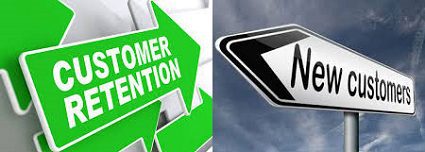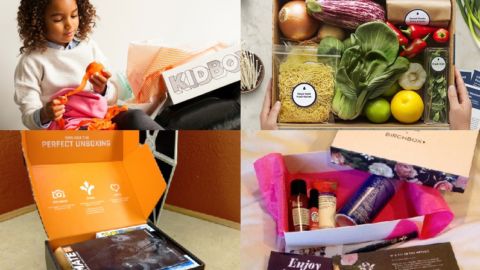It’s one of the eternal questions retailers face: Do we focus more on customer acquisition or on customer retention?
At first glance, the answer seems to be a no-brainer. Unless a retailer is totally new to the market — meaning acquiring customers is a matter of survival — retaining existing customers offers the double benefit of lower costs and higher returns. The cost of acquiring a new customer can range from five to seven times the expense of keeping an existing one. The probability of converting a new customer falls in the 5% to 20%range; for existing customers, it’s between 60% and 70%.
Yet despite these and dozens of other similar statistics, “Success for retailers and compensation for execs is often heavily tied to acquisition,” said Ernan Roman, President of ERDM Corp. “That is a mistake and drives the wrong behavior. Success has to encompass both effective acquisition and strategies which drive customer engagement and retention.”
Perhaps one of the reasons retailers focus on acquisition is that it offers quick wins and an easily measurable key performance indicator (KPI) for growth. In contrast, retention requires ongoing effort and a longer-term view of customer lifetime value.
While there may not be one fail-proof formula for effective customer retention, industry experts interviewed by Retail TouchPoints identified a number of key elements:
• Train front-line employees to focus on generating repeat business with every customer interaction;
• Provide VIP treatment for top customers to convert them into brand advocates;
• Involve customers in “behind-the-scenes” processes such as product development to make them feel like brand stakeholders; and
• Build communities of interest to generate customer loyalty that goes beyond brand, price and product.
Personal Relationships Are Key To Retention And Loyalty
Retailers need to look at every customer interaction to maximize the retention opportunity, according to Richard R. Shapiro, President of The Center For Client Retention. “I get so frustrated with retailers because they don’t leverage the customers they already have,” Shapiro said in an interview with Retail TouchPoints. “They should be spending their money to train their staff and hire the right people. In almost all cases, even if an associate provides a good customer experience, they don’t go far enough to generate repeat business.”
Shapiro added that this process can be as simple as having the associate say to a customer (let’s call her Mary) after the transaction has been concluded: “Mary, I enjoyed helping you today. I know what you want now, and I would enjoy seeing you again. We’re having a trunk sale on June 23rd that will have items you might be interested in.”
“That’s where you continue the relationship; otherwise it’s just one transaction at a time,” said Shapiro. “The strongest bond is between two specific people — not the brand and the customer, not the store and the customer.”
Acquisition-Retention Combinations Resonate With Customers
Because Mizzen+Main was launched just five years ago as a performance dress shirt retail brand, to date most marketing efforts have been focused on customer acquisition. But the company’s organic growth model, which leverages referrals and high-profile customers such as Mark Cuban, means that customer retention is built into the brand’s overall acquisition efforts.
“Up until about eight weeks ago, many people were still finding Mizzen+Main through their friends,” admitted CMO Jen Lavelle in an interview with Retail TouchPoints. “That provides a lot of opportunities for us, but it’s also frustrating, because we spend a lot of money and time trying to find people digitally.”
However, the recent release of a video that combines humor with product information and education already has generated more than 500,000 views — many of them by people who are just discovering the brand.
On the customer retention side, “We have deployed a whole team of people for our top customers, to ensure they have early access to our product launches,” Lavelle added. “We also offer round-the-clock concierge service, so if you are traveling to San Francisco and spill wine on your shirt on the plane, we can make sure you have a new shirt when you arrive.”
Calyx Flowers focused its efforts on the customer service provided through its call center when it shifted from customer acquisition into customer retention mode. The retailer used SaviLinx to improve what had been “robotic” call center interactions. The SaviLinx “Super Q” client service representatives handle the more complex customer requests; identify corporate accounts and transfer them to Calyx for direct follow-up; and provide the retailer with daily reports on number of orders taken, types of questions asked and the overall disposition of callers.
“We’re not interested in a one-and-done customer, said Calyx Flowers CEO Mark Ranalletti. “We’d rather have customer retention because we’d rather keep a customer than always trying to replace them with new customers.”
Extend Customer Relationships Beyond The Transaction
In addition to recognizing and rewarding top customers, some retailers are leveraging relationships to turn shoppers into brand advocates. Referral marketing programs are largely powered by “superfans,” and social media influencers often are enthusiastic customers first.
It’s easier today for retailers to involve these high-value shoppers in what had formerly been internal processes, such as product development and marketing campaign concepts. For example, top customers of Mizzen & Main are eager to serve as unofficial beta testers for its products. “A lot of our biggest fans want to be intimately involved with the business,” said Lavelle. “We have invited them into the development process, and we coordinate our innovation team with our VIP team.”
The balance of acquisition and retention has paid off. While the privately held retailer does not release sales numbers, “When someone purchases with us multiple times, their average order size grows significantly,” said Lavelle. That’s to be expected with a repeat customer of any retailer, but it’s a noticeable “bonus” for this brand: “Once someone gets a hold of Mizzen+Main and likes it, their cart value explodes,” said Lavelle.
To Build Customer Loyalty, Establish A Brand Community
In addition to new forms of customer engagement, retailers are discovering the benefits of building a community in retaining customers.
“The opportunity for retail brands is to tell a story that pulls the customer in,” said Kelly Stickel, President and Global Community Builder for Remodista in an interview with Retail TouchPoints. “Using community allows retailers to find a purpose in their brand that’s about something other than getting someone to buy something,” she added. “It’s about defining a higher calling, having a mission or purpose, and then you start attracting others who believe what you believe.”
Stickel, who moderated the 2017 Retail Innovation Conference panel discussion on community building, warned that while community-building pays big dividends, it requires a long-term investment. Often, that’s a commitment that retailers focused on their quarterly financial results may not be willing to make.
Truth in Aging began as more of a community than a traditional retailer. The business sells skin care products that are tested and endorsed by community members for at least 30 days. When Founder and CEO Marta Wohrle was building the brand, she would personally respond to every single shopper comment left on the site in order to create a dialogue that went beyond the product. Wohrle, a 2017 Retail Innovator Award winner and a speaker on the panel, noted that “building a community is generally a one-on-one process.”
“You have to build your community authentically,” said Stickel. “You can buy ‘likes’ and lists, but a purposeful community has to be built with integrity. In a world that gets bigger and more expansive, trusted communities and trusted marketplaces are going to be what wins long-term.”
For brands with the resources and patience to follow this path, “Community gives you the flexibility to do bigger things,” said Stickel. “If you build your audience authentically, you won’t have to pay for them.”
The precise ratio of acquisition to retention will vary for each retailer, but it seems clear that retention needs to be a higher priority in an age when shoppers have instant access to so many competing brands. As a first step, retailers need to educate their front-line employees to take proactive steps, laying the groundwork for an ongoing relationship with customers.
Retailers also should focus their efforts on their current top customers, encouraging them to become brand advocates by participating in referral programs and using social media to share their authentic stories about the brand. Additionally, involving these shoppers in “behind-the-scenes” processes can build a feeling of community, and community is critical to retention. After all, switching brands is relatively easy; leaving a community is far more difficult.












